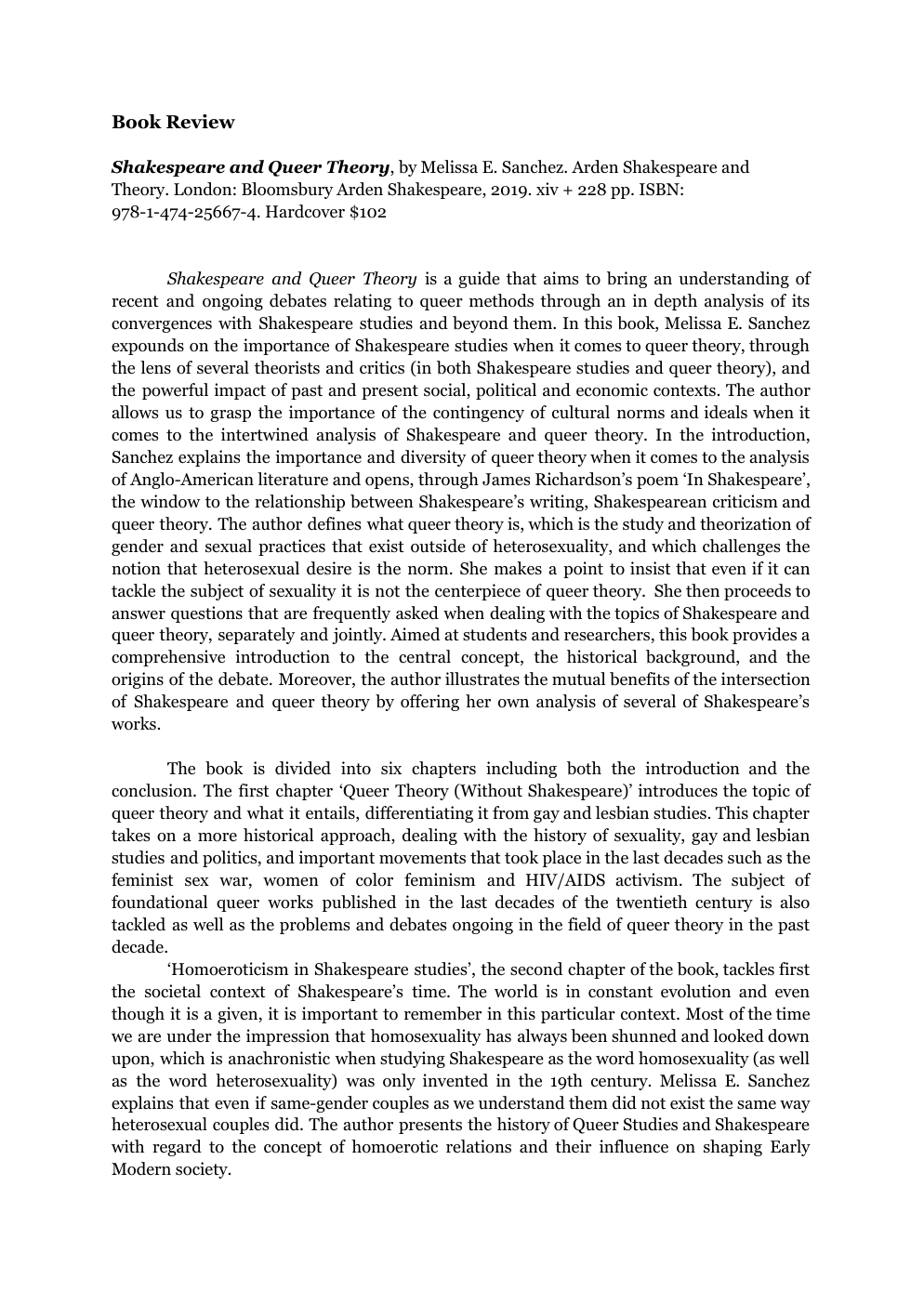Shakespeare and Queer Theory
Publié le 19/11/2024
Extrait du document
«
Book Review
Shakespeare and Queer Theory, by Melissa E.
Sanchez.
Arden Shakespeare and
Theory.
London: Bloomsbury Arden Shakespeare, 2019.
xiv + 228 pp.
ISBN:
978-1-474-25667-4.
Hardcover $102
Shakespeare and Queer Theory is a guide that aims to bring an understanding of
recent and ongoing debates relating to queer methods through an in depth analysis of its
convergences with Shakespeare studies and beyond them.
In this book, Melissa E.
Sanchez
expounds on the importance of Shakespeare studies when it comes to queer theory, through
the lens of several theorists and critics (in both Shakespeare studies and queer theory), and
the powerful impact of past and present social, political and economic contexts.
The author
allows us to grasp the importance of the contingency of cultural norms and ideals when it
comes to the intertwined analysis of Shakespeare and queer theory.
In the introduction,
Sanchez explains the importance and diversity of queer theory when it comes to the analysis
of Anglo-American literature and opens, through James Richardson’s poem ‘In Shakespeare’,
the window to the relationship between Shakespeare’s writing, Shakespearean criticism and
queer theory.
The author defines what queer theory is, which is the study and theorization of
gender and sexual practices that exist outside of heterosexuality, and which challenges the
notion that heterosexual desire is the norm.
She makes a point to insist that even if it can
tackle the subject of sexuality it is not the centerpiece of queer theory.
She then proceeds to
answer questions that are frequently asked when dealing with the topics of Shakespeare and
queer theory, separately and jointly.
Aimed at students and researchers, this book provides a
comprehensive introduction to the central concept, the historical background, and the
origins of the debate.
Moreover, the author illustrates the mutual benefits of the intersection
of Shakespeare and queer theory by offering her own analysis of several of Shakespeare’s
works.
The book is divided into six chapters including both the introduction and the
conclusion.
The first chapter ‘Queer Theory (Without Shakespeare)’ introduces the topic of
queer theory and what it entails, differentiating it from gay and lesbian studies.
This chapter
takes on a more historical approach, dealing with the history of sexuality, gay and lesbian
studies and politics, and important movements that took place in the last decades such as the
feminist sex war, women of color feminism and HIV/AIDS activism.
The subject of
foundational queer works published in the last decades of the twentieth century is also
tackled as well as the problems and debates ongoing in the field of queer theory in the past
decade.
‘Homoeroticism in Shakespeare studies’, the second chapter of the book, tackles first
the societal context of Shakespeare’s time.
The world is in constant evolution and even
though it is a given, it is important to remember in this particular context.
Most of the time
we are under the impression that homosexuality has always been shunned and looked down
upon, which is anachronistic when studying Shakespeare as the word homosexuality (as well
as the word heterosexuality) was only invented in the 19th century.
Melissa E.
Sanchez
explains that even if same-gender couples as we understand them did not exist the same way
heterosexual couples did.
The....
»
↓↓↓ APERÇU DU DOCUMENT ↓↓↓
Liens utiles
- Portia and Brutus in Shakespeare's Julius Caesar, Scene
- William Shakespeare I INTRODUCTION William Shakespeare English playwright and poet William Shakespeare, who lived in the late 1500s and early 1600s, is regarded as the greatest dramatist in the history of English literature.
- Matrix Theory and Linear Algebra I INTRODUCTION Matrix Theory and Linear Algebra, interconnected branches of mathematics that serve as fundamental tools in pure and applied mathematics and are becoming increasingly important in the physical, biological, and social sciences.
- Number Theory I INTRODUCTION Number Theory, branch of mathematics that deals with the properties and relationships of numbers (see Number).
- Quantum Theory I INTRODUCTION Quantum Theory, in physics, description of the particles that make up matter and how they interact with each other and with energy.

































